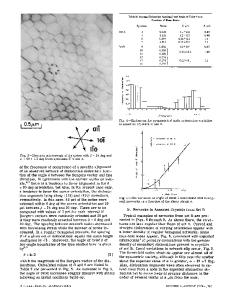Dislocation Multiplication in the Early Stage of Deformation in Mo Single Crystals
- PDF / 2,988,384 Bytes
- 6 Pages / 417.6 x 639 pts Page_size
- 87 Downloads / 336 Views
L. M. Hsiung and D. H. Lassila Lawrence Livermore National Laboratory, Materials Science and Technology Division, L-369, P.O. Box 808, Livermore, CA 94551-9900, [email protected]
ABSTRACT Initial dislocation structure in annealed high-purity Mo single crystals and deformation substructure in a crystal subjected to 1% compression have been examined and studied using transmission electron microscopy (TEM) techniques in order to investigate dislocation multiplication mechanisms in the early stage of plastic deformation. The initial dislocation density is in a range of 106 - 10' cm 2 , and the dislocation structure is found to contain many grown-in superjogs along dislocation lines. The 2 dislocation density increases to a range of 10' - 109 cm- , and the average jog height is also found to increase after compressing for a total strain of 1%. It is proposed that the preexisting jogged screw dislocations can act as (multiple) dislocation multiplication sources when deformed under quasi-static conditions. The jog height can increase by stress-induced jog coalescence, which takes place via the lateral migration (drift) of superjogs driven by unbalanced line-tension partials acting on link segments of unequal lengths. The coalescence of superjogs results in an increase of both link length and jog height. Applied shear stress begins to push each link segment to precede dislocation multiplication when link length and jog height are greater than critical lengths. This "dynamic" dislocation multiplication source is suggested to be crucial for the dislocation multiplication in the early stage of plastic deformation in Mo. INTRODUCTION The main purpose of this study is to examine, analyze the initial dislocation structure and deformation substructure of Mo single crystals in order to provide detailed physical mechanisms to facilitate multiscale modeling and dislocation dynamics simulation [1]. For the success of simulation, it is of paramount importance to have a systematic and rigorous study on dynamic properties of dislocations including dislocation multiplication, motion, and dislocation interaction. Since the initial dislocation structures (dislocation density, dislocation configuration, free dislocation link length, kink and jog density...) can all affect dislocation dynamics during subsequent plastic deformation, the dislocation substructures in as-annealed and quasi-statically compressed Mo crystals were studied and compared. Emphasis has been placed upon the role of initial dislocation structures in dislocation multiplication and motion during early stages of plastic deformation. EXPERIMENT The Mo single crystals used for dislocation dynamics experiment must have low dislocation density in order to analyze the structure with TEM and to subsequently establish initial conditions for simulation. Mo single crystals were obtained from Accumet Materials Company, Ossining, NY. The interstitial impurities (ppm in weight) in Mo are 0: 25; N:
Data Loading...









